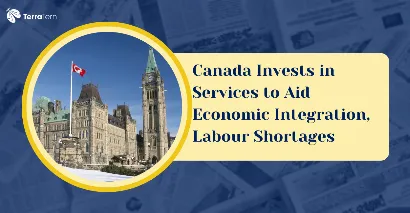Key Highlights
- The Scope of Federal Investment and Its Impact
- Tackling Labour Market Shortages: Sectoral Overview
- Job-Specific Services: From Credential Recognition to Language Training
- New Focus: French-Speaking Newcomers and Francophone Communities
- Supporting Regional Settlement: A Closer Look
- Expanding Immigration Pathways in 2025
- Settlement Services: What’s Included?
- Tracking Labour Market Trends: Statistics, Wages, and Employment Gains
- Meeting the Challenge: Stakeholder Feedback & Future Steps
- Tables: Reference Data From 2025
- Conclusion
The key keyword Canada commits to in services to help the economy integrate and fill in the labour gap is not just a national program of the government but also a national strategy of stability and growth. In response to short-term and long-term labour demands, integration of the newcomers is considered the solution to problems as demand for skilled workers increases and the country tries to maintain the position of the strongest economy within the G7. The program offers a local, tailor-made approach, leaving behind the generic solutions and going to regional and industry-based assistance.
Also Read: Immigration To Canada From India: All Different Pathways
The Scope of Federal Investment and Its Impact
The Honourable Lena Metlege Diab, Minister of Immigration, Refugees and Citizenship, announced that it budgeted $3.2 billion over three years, July 23, 2025. Funding will flow to more than 520 organisations nationwide (excluding Quebec) and is designed to help new arrivals enter the job market with the proper support, addressing acute shortages in essential sectors like healthcare and skilled trades.
|
Category |
Details |
|
Organizations Funded |
520+ organisations across Canada (excluding Quebec) |
|
Funding Amount |
$3.2 billion over three years |
|
Program Start Date |
April 1, 2025 |
The investment under the IELP is flexible enough to fit particular local labour needs. This program is flexible, instead of a one-size-fits-all approach, driven by programs and funding according to the local labour markets.
How Settlement Organisations Build Pathways for Newcomers?
New arrivals need to be helped in creating stable and prosperous lives through settlement and resettlement services. These organisations:
-
Help in obtaining a license and credential recognition in controlled professions
-
Provide both on-the-job training in language and general language teaching with English and French
-
Offer specific assistance to the French-speaking newcomers settling elsewhere in Canada
-
Establish local industry and network partnerships
The multilateral selection of organisations based on a competitive national process is necessary to have, among other things, eligibility, fit, affordability, and documented ability to answer the needs of newcomers.
Tackling Labour Market Shortages: Sectoral Overview
The shortages in the labour market are particularly acute in areas such as health, education, technology, and construction and skilled trades. The need to have responsive and evidence-based programs has become even more exacerbated by the growing population of Canada and the ageing workforce.:
-
The unemployment rate slightly recovered in June 2025 to 6,9%. Thus, this indicates an improvement but also indicates industry imbalances.
-
The number of people who found employment also increased in significant areas like the wholesale, retail trade and healthcare.
-
The government also lists persistent skills shortages as a crucial problem, so it invests in credential recognition, training, and occupation-specific settlement support.
|
Metric |
Value |
|
Employment Rate (June 2025) |
60.9% |
|
Unemployment Rate (June 2025) |
6.9% |
|
Average Hourly Wage Growth YoY |
+3.2% |
|
Provinces with Employment Increase |
Alberta (+30,000), Quebec (+23,000), Ontario (+21,000), Manitoba (+8,500) |
|
Provinces with Employment Decrease |
Newfoundland and Labrador (-3,500), Nova Scotia (-3,400) |
Also Read: Navigating Canada's Strategic Overhaul of the Temporary Foreign Worker Program
Job-Specific Services: From Credential Recognition to Language Training
The settlement organisations provide:
-
Licensing and professional accreditation endorsement
-
Larger-scale language training according to the workplace aesthetic
-
The possibility of matching international qualifications with the Canadian standard.Opportunities to bridge international qualifications with Canadian standards
-
Appointment to positions of high demand through local alliances
-
Healthcare, trade, and technology sector and public services-specific curriculum
Recent news features indicate that recognition of credentials and language training are key to the fast induction of skilled immigrants who will fill the labour shortage in the area and enable new migrants to pursue careers in their trained profession.
New Focus: French-Speaking Newcomers and Francophone Communities
The support the French-speaking immigrants receive in Canada has been enlarged:
-
The project Welcoming Francophone Communities will run to 24 communities in 20 25 2026
-
In 2025, a new Community Immigration Class is created to increase the number of French-speaking immigrants who do not settle in Quebec
-
Dedicated Express Entry pools that target French-speaking applicants all have lower minimum scores and more direct pathways to permanent residence, and CRS cut-offs have plummeted in targeted draws
-
In March 2025, the government declared $9.3 million in support projects for Francophone. In March 2025, the government declared an amount of $9.3 million in Francophone support projects
|
Criteria |
Description |
|
Certificate of Recommendation |
Valid certificate from an economic development organisation |
|
Genuine Job Offer |
Genuine offer from designated employer |
|
Work Experience |
Meets specific work experience conditions or a waiver for some graduates |
|
Language Proficiency |
French language ability at NCLC level 5 in all abilities |
|
Education |
At least a secondary school level credential |
|
Intent to Reside |
Must intend to live in the designated community |
|
Necessary Funds |
Funds equivalent to half of the most recent Low-Income Cut-off for one year |
|
Temporary Status (for in-Canada applicants) |
Valid temporary status maintained until permanent residence is granted |
Also Read: Provincial Nomination in Canada: Your Immigration Path
Supporting Regional Settlement: A Closer Look
The scenes have experienced significant improvements in employment, mainly in provinces such as Alberta, Quebec and Ontario through concerted settlement efforts.
-
In June 2025, Alberta gained 30,000 positions, partially thanks to the involvement of local newcomer integration.
-
Quebec increased its attempts to retain skilled immigrants, especially in the province's health care and professional services.
-
Ontario is the biggest province, and it is intensifying its relations with the industry, enhancing settlement results, and enabling economic stability.
Document services assist newcomers to the country economically, socially, and culturally, which benefits the economy and the individual.
Expanding Immigration Pathways in 2025
The 2025 government of Canada immigration strategy is tailored towards an economic-based entry.
-
Provincial Nominee Program (PNP), Atlantic Immigration Program, and new EMPP streams are growing to target local skill gaps.
-
It is estimated that by 2027, 62 per cent of admissions as permanent residents will be based on economic categories.
-
Express Entry emphasises candidates with Canadian work experience, French language skills, and in-demand sector backgrounds (especially healthcare, skilled trades, and teaching)
-
Categories A, B and C selection of permanent residency is now available to in-demand occupations.
There will be four additional new permanent residency pathways in 2025, namely those targeting home care workers, rural communities, and those who are French-speaking and not living in Quebec.
Settlement Services: What’s Included?
Lots of specific supports are provided by local agencies, such as:
-
On-the-job and general language education (English/French)
-
Licensing, credential and professional accreditation support
-
Sociocultural orientation
-
Shelter and family service
-
Special initiatives for underrepresented groups (seniors, racialised newcomers, youth)
By April 1, 2025, 47 per cent of all non-Quebec permanent residents and 93 per cent of resettled refugees had availed themselves of at least one settlement service.
Also Read: Canada Deportation: 12 Scenarios That Can Cause Deportation From Canada
Tracking Labour Market Trends: Statistics, Wages, and Employment Gains
The labour market trends are:
Labour Market Health in Canada:
-
In June 2025, the labour force increased by 25.0 per cent to 60.9 per cent
-
The average per-hour wages among employees grew at 3.2 per cent to reach $36.01
-
Earning groups in Alberta, Quebec, Ontario, and Manitoba increased, whereas Newfoundland, Labrador, and Nova Scotia also decreased slightly.
Settlement programs are revised annually to meet the changing labour demands in the labour market, which can be observed in the latest adjustments demonstrated by national and provincial data.
Meeting the Challenge: Stakeholder Feedback & Future Steps
The challenges are highlighted below:
Organisations Chosen:
-
Demonstrate adherence to government programs' priorities
-
Demonstrate capability to customise services to fit special community needs
-
Create cost-efficiency and promising results for newbies
The recent transition to outcome-oriented support signifies a new age in handling labour shortages and incorporating immigrants into the country. One key to success continues to be sector-specific programs, employer partnership, and language training on the job.
Reference Data From 2025
Here is the table for reference:
|
Category |
Details |
|
Organizations Funded |
520+ organisations across Canada (excluding Quebec) |
|
Funding Amount |
$3.2 billion over three years |
|
Program Start Date |
April 1, 2025 |
Labour Market 2025: Key Indicators
|
Metric |
Value |
|
Employment Rate (June 2025) |
60.9% |
|
Unemployment Rate (June 2025) |
6.9% |
|
Average Hourly Wage Growth YoY |
+3.2% |
|
Provinces with Employment Increase |
Alberta (+30,000), Quebec (+23,000), Ontario (+21,000), Manitoba (+8,500) |
|
Provinces with Employment Decrease |
Newfoundland and Labrador (-3,500), Nova Scotia (-3,400) |
Francophone Community Immigration Class (FCIC) Eligibility
|
Criteria |
Description |
|
Certificate of Recommendation |
Valid certificate from an economic development organisation |
|
Genuine Job Offer |
Genuine offer from designated employer |
|
Work Experience |
Meets specific work experience conditions or a waiver for some graduates |
|
Language Proficiency |
French language ability at NCLC level 5 in all abilities |
|
Education |
At least a secondary school level credential |
|
Intent to Reside |
Must intend to live in the designated community |
|
Necessary Funds |
Funds equivalent to half of the most recent Low-Income Cut-off for one year |
|
Temporary Status (for in-Canada applicants) |
Valid temporary status maintained until permanent residence is granted |
Also Read: A Comprehensive Guide to Express Entry Canada
Conclusion
The preparation of a strong and dynamic national economy aims to attract economic integration and a labour market to fill any unfulfilled gaps through investments in services in Canada. Addressing both gaps in local areas with targeted assistance, streamlining the credential recognition process, and providing regional programs to French-speaking and highly skilled immigrants, Canada is not only filling today's shortages but is already securing long-term sustainability.
To stay updated with the latest immigration news, contact TerraTern right away!








